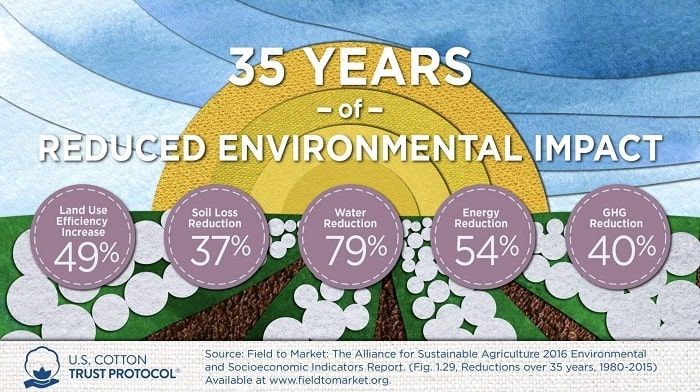Everything comes down to water use. Whether it’s in our own personal lives or the fashion brands we patronize, lowering our water use is a significant part of how we all reduce our environmental impact. And it matters in the materials that fashion brands decide to source.
Contrary to popular belief, cotton is not a water-intensive crop. It has been bred to be drought-tolerant, and in many parts of the world, it relies solely on rainfall. In fact, the majority of cotton grown in the U.S. uses little to no irrigation. When comparing water efficiency market to market, on average U.S. cotton farmers outperform their competitors. Almost all cotton grown elsewhere is 100 percent irrigated; in actuality, two-thirds of U.S. cotton is not irrigated at all.

U.S. growers use moisture sensors and below-ground probes to track and map where water is needed throughout their fields. They use irrigation scheduling technology and drip irrigation to ensure water is soaked into the ground. Thanks to these innovations and technologies, U.S. cotton growers have reduced water use by 79 percent over the past 35 years.
The U.S. Cotton Trust Protocol aims to tell the true story about U.S. cotton and its water use. With a growing demand for transparency about apparel brands’ and retailers’ water use and their raw materials, the Trust Protocol sets a new standard for more sustainably grown cotton. It brings quantifiable and verifiable goals and measurement and drives continuous improvement in key sustainability metrics.
The Trust Protocol underpins and confirms U.S. cotton’s sustainability progress through sophisticated data collection and independent third-party verification. Choosing Trust Protocol cotton will give brands and retailers the critical assurances they need that the cotton fiber element of their supply chain is more sustainably grown with less water, as well as lower environmental and social risk.

In the face of climate change, brands and retailers have set comprehensive sustainability plans with significant objectives for their businesses. And U.S. cotton growers are continuously improving their sustainability practices by employing new technologies to lower their water use. This is why the Trust Protocol has ambitious sustainability goals for six metrics aligned with the United Nations Sustainable Development Goals, including an 18 percent water use reduction by 2025.
“Once the crop is planted, our main technology is irrigation monitoring. We’ve got soil probes in the field and use satellite imagery. We’ve got an agronomist that helps with irrigation scheduling and crop coefficients,” said Aaron Barcellos, a Trust Protocol grower participant from California.
“This is an area where we’ve seen major improvements. Before, it used to take 24 to 28 inches of water to grow a cotton crop using flood irrigation. Now we’re averaging 18 to 20 inches of water using drip irrigation.”
Growers have adopted systems like computer-driven moisture sensors to improve water efficiency by alerting them to periods of sufficient rainwater and showing them water-level measurements at a series of distances below ground level. By using this picture of the soil’s moisture at all levels, farmers can irrigate their fields more efficiently—if irrigation is needed at all. Today, almost 63 percent of U.S. cotton growers now employ some type of precision technology on their farms.
With access to the Trust Protocol, growers can continue to employ technology to improve their farm’s sustainability and water use. This access includes peer data to baseline their own operations, verified data year-over-year to measure their progress, and insights and best practices from across the industry, all of which allow growers to advance their work toward the Trust Protocol’s ambitious goals.
The U.S. Cotton Trust Protocol has welcomed more than 450 brand, retailer, mill and manufacturer members since it opened enrollment six months ago. This includes brands in the PVH Corp, Levi Strauss & Co. and Gap Inc. portfolios, as well as global apparel manufacturer Gildan. The Trust Protocol has also added U.K. retailers Tesco, Byford and Next Plc. The Trust Protocol also has welcomed the first U.S. mills, the first members in Latin America, and Advance Denim, one of China’s top three denim manufacturers. These members have joined to better understand the sustainability progress of U.S. cotton and communicate that progress to customers.
It’s on all of us—growers, brands, retailers and consumers—to use water more responsibly. The U.S. Cotton Trust Protocol allows each of us to trust that we’re using less of our natural resources when it comes to the clothes we wear.
















